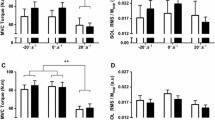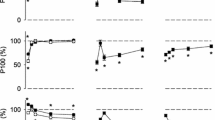Summary
Thirty young male adults matched in two experimental groups (n=12) and a control group (n=6) were investigated before and after an 8-week strength training period. Group A trained with few repetitions and maximal loads, whereas group B had more repetitions with smaller loads. Both groups lifted the same total load during each training period, four times a week. Maximal voluntary strength (MVS) of a shot-put arm movement, muscular excitability and contractile properties (time to peak of contraction with threshold stimuli, half relaxation time) were measured in M. deltoideus and M. triceps brachii, C. longum, for two durations of stimulation. Increases of 14.8% (group A) and 12.2% (group B) in MVS were observed. Muscle excitability significantly increased in all types of training and both muscles. Significant shortening of the contraction time, dependent on the type of training, was observed in both studied muscles. It appears that the strength training in group A involved the fast fibers of both muscles, whereas in group B the training influence was less marked, and affected both fast and slow fiber types.
Similar content being viewed by others
References
Absaljamov T, Zorin W, Koz J (1976) Kontraktionsgeschwindigkeiten von Muskeln und ihre VerÄnderung im sportlichen Training. Leistungssport 6: 58–61
Bosco C, Komi PV (1979) Mechanical characteristics and fiber composition in human leg extensor muscles. Eur J Appl Physiol 41: 275–284
Boileau R, Massey B, Misner J (1973) Body composition changes in adult men during selected weight training and jogging programs. Res Q 44: 158–168
Bourguignon G, Humbert R (1947) Triple contraction et triple chronaxie du muscle strié normal de l'homme et des mammifères. C R Soc Biol 141: 549–555
Bourguignon G, Bourguignon A (1949) Les trois chronaxies du nerf et du point moteur. C R Soc Biol 143: 780–781
Buchberger J, Novozamski V (1971) Motor excitability in trained and untrained children. Eur Neurol 5: 7–10
Buchthal F, Schmalbruch H (1970) Contraction times and fibre types in intact human muscle. Acta Physiol Scand 79: 435–452
Bührle M, Schmidtbleicher D (1977) Einflu\ von Maximalkrafttraining auf die Bewegungsschnelligkeit. Leistungssport 7: 3–10
Burke R, Edgerton VR (1975) Motor unit properties and selective involvement in movement. Exercise Sport Sci Rev 3: 31–81
Costill D, Coyle E, Fink W, Lesmes G, Witzmann F (1979) Adaptations in skeletal muscle following strength training. J Appl Physiol 46: 96–99
Dons B, Bollerup K, Bonde-Petersen F, Hancke J (1979) The effect of weight-lifting exercise related to muscle fiber composition and muscle cross-sectional area in humans. Eur J Appl Physiol 40: 95–106
Eberstein A, Goodgold J (1968) Slow and fast-twitch fibers in human skeletal muscle. Am J Physiol 215: 535–541
Fischer E (1971) In: Licht S (ed) Electrodiagnosis and electromyography. Wawerly-Press, Baltimore, pp 66–112
Gydikov A, Kosarov D (1973) Physiological characteristics of the tonic and phasic motor units in human muscle. In: Gydikov A, Tankov N, Kosarov D (eds) Motor Control. Plenum Press, New York, pp 75–94
Hanson J (1974) Effects of repetitive stimulation on membrane potentials and twitch in human and rat intercostal muscle fibers. Acta Physiol Scand 92: 238–248
Haralambie G (1970) Untersuchungen über neuromuskulÄre Erregbarkeit bei Sportlern. Electromedica 38: 271–273
Haralambie G (1973) Neuromuscular irritability and serum creatine phosphate kinase in athletes in training. Int Z Angew Physiol 31: 279–288
Haralambie G, Berg A (1978) Creatine kinase and hexose phosphate isomerase activity in skeletal muscles of healthy male adults. Enzyme 23: 104–107
Holloszy JO, Booth FW (1976) Biochemical adaptations to endurance exercise in muscle. Ann Rev Physiol 38: 273–291
Jennekens F, Tomlinson B, Walton J (1971) Data on the distribution of fibre types in five human limb muscles. An autopsy study. J Neurol Sci 14: 245–257
Johnson MA, Polgar J, Weightman D, Appleton D (1973) Data on the distribution of fibre types in thirty-six human muscles. An autopsy study. J Neurol Sci 18: 111–129
Komi PV (1979) Neuromuscular performance: Factors influencing force and speed production. Scand J Sports Sci 1: 2–15
Komi PV, Viitasalo JT, Rauramaa R, Vihko V (1978) Effect of isometric strength training on mechanical, electrical, and metabolic aspects of muscle function. Eur J Appl Physiol 40: 45–55
Oester YT, Licht S (1971) In: Licht S (ed) Electrodiagnosis and electromyography. Wawerly-Press, Baltimore, pp 201–217
Partheniu A (1967) L'intervalle phasico-tonique de l'excitabilité neuro-musculaire. Int Z Angew Physiol 24: 333–350
Schmalbruch H (1970) Die quergestreiften Muskelfasern des Menschen. Springer, Berlin Heidelberg New York
Schmidtbleicher D (1980) Maximalkraft und Bewegungsschnelligkeit. Limpert, Bad Homburg
Sica R, McComas AJ (1971) Fast and slow twitch units in a human muscle. J Neurol Neurosurg Psychiatr 34: 113–120
Thorstensson A (1976) Muscle strength, fibre types, and enzyme activities in man. Acta Physiol Scand [Suppl] 443: 45p
Thorstensson A, Sjödin B, Karlsson J (1975) Enzyme activities and muscle strength after “sprint training” in man. Acta Physiol Scand 94: 313–318
Thorstensson A, Hultén B, von Döbeln W, Karlsson J (1976) Effect of strength training on enzyme activities and fibre characteristics in human skeletal muscle. Acta Physiol Scand 96: 392–398
Walthard K, Tchicaloff M (1971) In: Licht S (ed) Electrodiagnosis and electromyography. Wawerly-Press, Baltimore, pp 153–170
Author information
Authors and Affiliations
Rights and permissions
About this article
Cite this article
Schmidtbleicher, D., Haralambie, G. Changes in contractile properties of muscle after strength training in man. Europ. J. Appl. Physiol. 46, 221–228 (1981). https://doi.org/10.1007/BF00423398
Accepted:
Issue Date:
DOI: https://doi.org/10.1007/BF00423398




